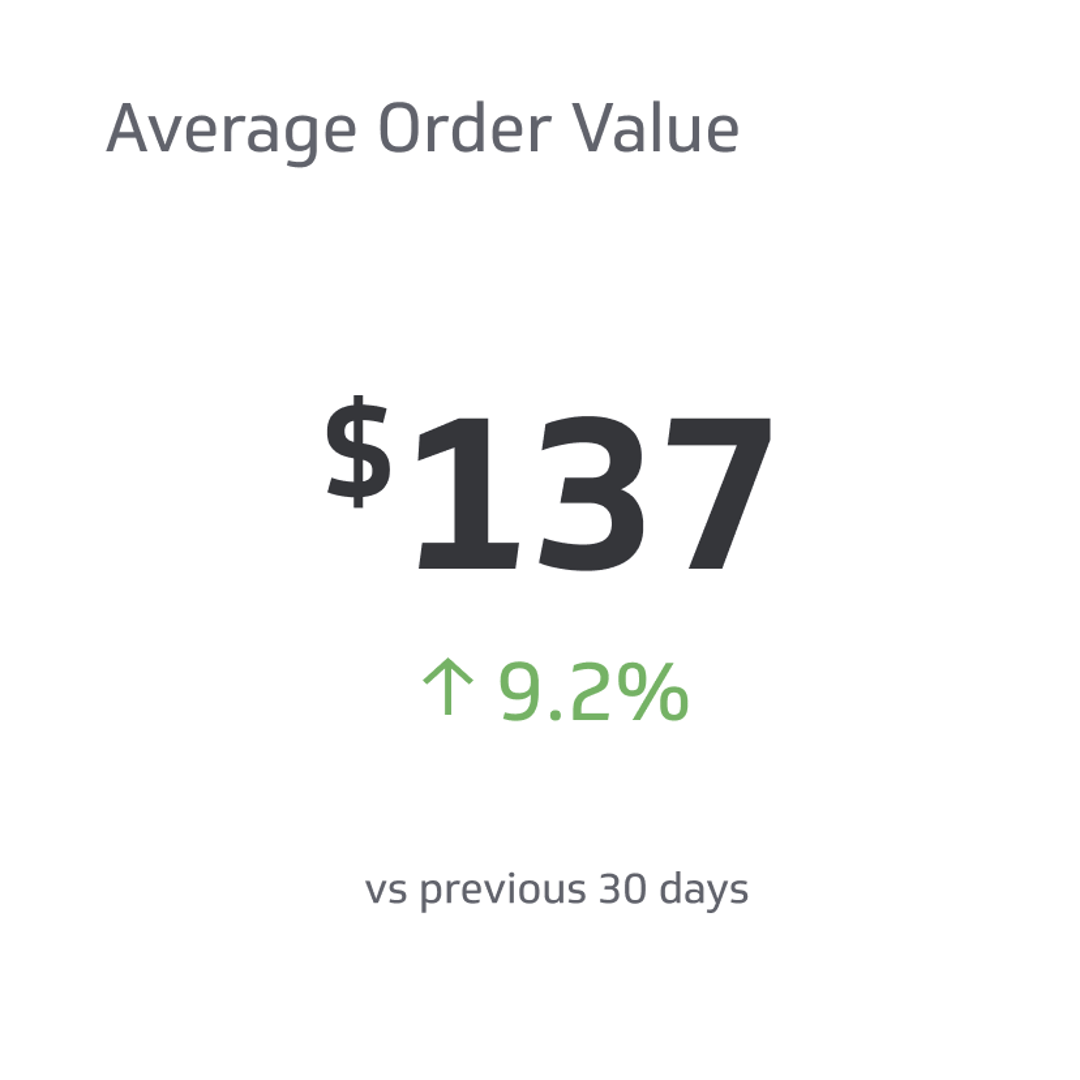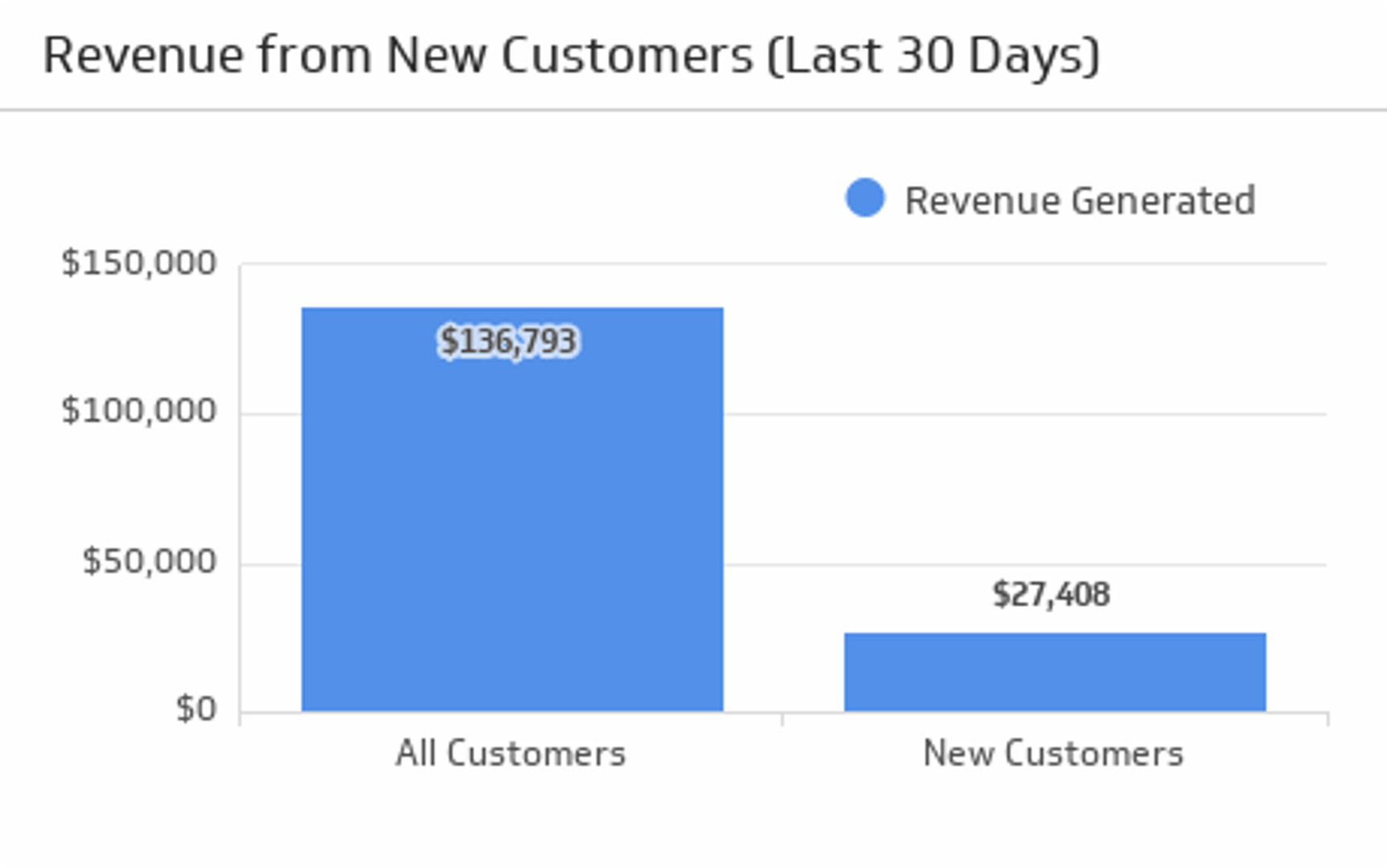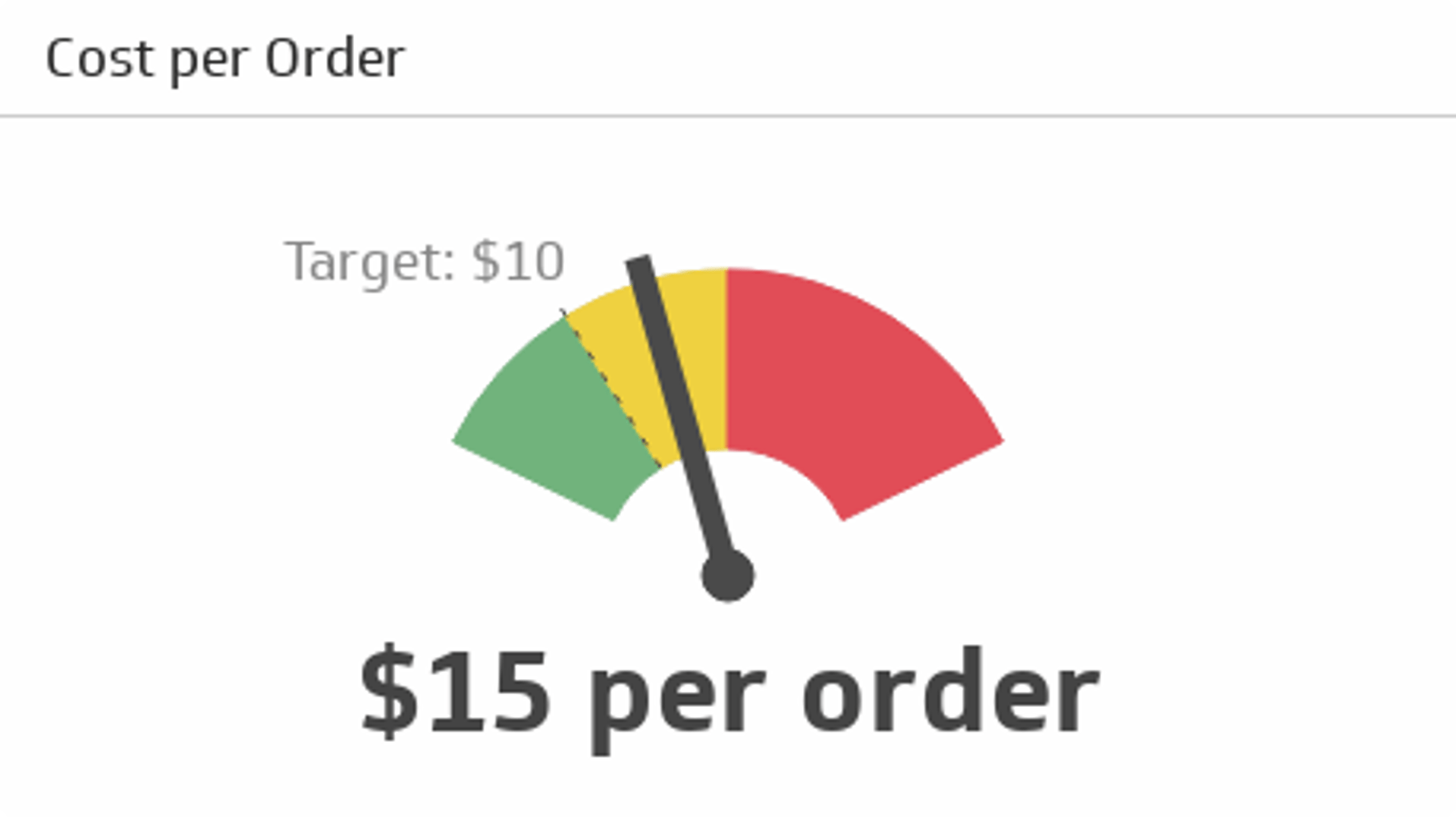Average Order Value (AOV)
The average order value is the dollar value per order during a certain period.
Track all your Ecommerce KPIs in one place
Sign up for free and start making decisions for your business with confidence.

When it comes to metrics, no industry loves it more than eCommerce. Average order value is one of many eCommerce metrics, but this metric stands out for a specific reason, it helps determine how much value an online store gets from each order on its store.
AOV directly impacts how a business looks at its pricing, marketing, and even promotions. Of course, the metric's importance depends on the eCommerce business's specialty, but generally, every online store should understand what AOV is and how it affects them.
What Is Average Order Value?
AOV is an important concept, and it's relatively simple to understand. The average order value is the dollar value per order during a certain period. Whether daily, monthly, quarterly, or annually, you can measure it and find your average order value.
eCommerce businesses use AOV to measure their businesses' health and determine whether they can improve their efforts to get a better return from every online order from their store.
The Formula for Average Order Value?
There's nothing complex about the average order value formula. To get your AOV, you'll want to divide your revenue by the number of orders your business had within that time. For example, if you want to calculate your AOV and have $38,000 in total revenue and have 1400 orders ($38,000/1400), your AOV is $27 for that month.
You can calculate your AOV for any given period, but most choose to do it every month. Even so, it's important to remember that formula is the same regardless of time length, whether daily, bi-weekly, monthly, or annually.
What's the Purpose of Average Order Value?
The average order value's main purpose is to give eCommerce businesses an idea of how to approach and adjust their business strategies. Since AOV doesn't provide many details besides the average value of your orders, some eCommerce businesses think it's not a valuable KPI to formulate a strategy around.
Even though it doesn't give specific details, it gives businesses enough information to gauge whether or not marketing and pricing strategies are working. Consider this, a higher order value means more money per order, and consumers are happy to spend more. In that case, marketing and pricing strategies seem to be working.
If your AOV is low, you know that marketing and pricing strategies aren't working as you intend. From there, you can go into more detail about your strategies' whys and hows. That's the main purpose of your AOV, quick to calculate and easy to investigate.
Why Is Average Order Value Important?
AOV is important because of the costs that go into each order. When a consumer orders a product online, it costs the business money to acquire that consumer and fulfill that order. So, the higher the order value, the more it offsets the costs of getting that order.
Would you rather make $20 off every order or $30? It's not a trick question. The average business person would want to make the higher number, which means they get a higher return on that order.
Getting a higher return per order means that the consumer is buying plenty of your products or purchasing your more expensive ones, which is very good. More money means spending more on marketing, product quality, or expansion.
How Does Your Average Order Value Affect Your Business?
Your average order value affects your business in numerous ways. Your AOV greatly impacts how much you spend per customer, pricing strategy, and store layout. Entire strategies are built around your average order value and for a good reason.
Since plenty of factors go into each order, a business gets a plethora of information on what factors affect their AOV. Think about this example. If your average order value is higher during certain holidays, you can deduce that people often buy bulk from your business during holidays.
In contrast, if they find that their average order value is lower during certain holidays, customers aren't buying as many products per order or not buying their higher-priced products. That information alone tells a business plenty.
First, the season or time directly impacts the AOV of the business, which means they can expend marketing efforts to increase sales and raise the value during high-profile periods such as holidays. While on the down season with low AOV, they can focus on upselling strategies, promotions, or product pricing to get a better return on each consumer order.
Another indicator is whether or not marketing efforts had anything to do with a higher AOV during that time. If so, you can determine that the marketing campaign succeeded, and your business can improve its marketing efforts.
Ways To Improve Your Average Order Value
Just like any KPI, specific methods can help you improve your AOV. Depending on what your business does and the product they sell, you may need to adjust your AOV improvement strategies. Regardless, these methods can help you improve your AOV:
- Get your customers to spend more: Your first thought when trying to improve your AOV should be how to get your customers to spend more. Consider what your average customer values when they purchase from your store and find creative ways to get them to spend a little more. For example, maybe offer a rewards program for spending a certain amount per order.
- Change your store layout: If your website is difficult to navigate or products aren't in the right place within your online store, you may find that your AOV is low. Tinker around with it to put high-value products in front of the consumer more. It could make a world of difference.
- Upselling: A common method for improving your AOV is upselling. Consider upselling as tagging less valuable items to an order for a few more dollars. For consumers, the extra few dollars to get a better deal is enticing enough to accept offers.
- Deals and Discounts: Volume discounts and sales are great ways to improve your AOV. Offer your consumer an incentive to purchase an item in bulk, similar to how wholesale sellers operate. As a result, you move your inventory faster and get more money per order.
- Marketing: Formulating an effective marketing campaign may be just what you need to improve your AOV. Test the waters and see what sticks. Research and work with your marketing team to create a short-term campaign to boost your AOV.
- Coupons: Online coupons are growing in popularity as more people shop online. Take advantage of the trend and offer coupons for bulk orders or exclusive discounts on certain products.
- Offer free shipping: An extremely common way to improve your AOV is by offering free shipping after an order exceeds a certain amount. Most people who shop online typically expect free shipping offers now, so it's an easy fix if your AOV is low.
- Emphasize Your Return Policy: Common hurdle for consumers buying expensive products is going through buyer's remorse. A great return policy helps alleviate consumers' fears about purchasing costly products online.
Average Order Value and eCommerce
For eCommerce businesses, there's no metric more important than average order value. Because of the shipping costs and work associated with each order, having a higher order value means you get more value from each order.
The easiest way for eCommerce businesses to understand how important AOV is to them is through shipping costs. For example, if it costs your business $10 to ship each order, and on average, consumers spend $50, you'll profit $40 per order.
Remember, in most cases, your AOV could be better, so you should strive to raise your AOV to get the best value for your business and your customer. That example was simple, but It's not just shipping costs you must consider.
Each order has expenses that go with it, so having a higher AOV means getting more value from marketing efforts and shipping costs. Other factors include inventory storage fees, marking costs, and administration fees.
Is Average Order Value the Same as Average Transaction Value?
While AOV and ATV sound similar, they're not the same thing. Average order value focuses on the average value of orders within a given period. In contrast, average transaction value focuses strictly on how much a consumer spends on each transaction.
That still may not be clear to some, but thinking about it this way may help you. Within one order, you can have multiple transactions, so getting an average order value means directly comparing the value of that entire order to your revenue.
Regarding ATV, you're getting information on each transaction within that order. Additionally, the formula is different. To get your ATV, divide your total monthly sales by the number of transactions you had within that period.
What's More Important Average Order Value or Average Transaction Value?
For eCommerce, understanding your AOV is essential. Even so, both metrics are important in their own way, and depending on your business, one may be more valuable than the other. For example, regarding pricing strategy, ATV is the metric of choice for many eCommerce businesses.
If eCommerce businesses find that they have a low average transaction value, they may reconsider their pricing strategy for certain items in their store. A low ATV normally indicates that consumers aren't buying your expensive products or that your pricing is too low.
On a micro level, your average transaction value is extremely useful because, from that information, you can find ways to improve the value of each transaction for the consumer and make more money for each item you sell.
Frequently Asked Questions
Here are some common questions people have that relate to AOV.
What is the average sales order?
This question commonly arises online, but it's important to note that it's just a common mistake when people are referring to the average order value. Since it's common, you may find someone using it instead of AOV, but they mean the same thing.
What does high AOV mean?
A high AOV means your orders are getting a higher value than average within your industry. If you're curious, try figuring out your competitor's AOV and comparing it to yours. If it's higher than yours, try developing a strategy to improve your AOV. If it's lower than yours, rejoice and celebrate.
Is average order value an important KPI?
No matter what people say, yes, AOV is an important KPI. The information you get from your average order value helps you develop appropriate marketing and pricing strategies. Additionally, it helps you gauge where you stand with your competitors in your industry.
Bottom Line
Your average order value is an important e-commerce metric to consider. While it doesn't provide as much in-depth detail as other KPIs, it's easy to calculate and understand for many eCommerce businesses. If you need to know how effective your marketing or pricing efforts are, calculate your AOV and see if there's any noticeable change.
If you need to improve your AOV, remember to take advantage of upselling techniques, provide discounts, and offer incentives for consumers to spend more per order.
Related Metrics & KPIs



